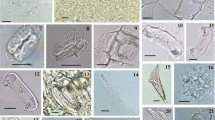Abstract
SOME of the opal phytoliths in the fine sand fractions of certain British soils have been traced to the grasses Sieglingia decumbens and Molinia caerulea 1 and it now appears that the largest of these arise in the bulliform cells of these species. As obtained from the soil or in residues prepared from the leaves, they appeared with fan-shaped outlines (Fig. 1), or with rectangular outlines, rather tabular but thinning to one edge, their surfaces often carrying one or two parallel ribs (Fig. 2). Using methods previously described2, we have observed similar bodies in situ in the bulliform cells of Chusquea culeou (Figs. 3–6) and Brachypodium pinnatum. The arrangement of bulliform cells resembles in many ways the architecture of a long semicircular arch (Fig. 7), the upper blocks having the broadest and most fan-like section (A, A′). In the plant the units (that is, the cells) are unequal and the long ones may be pressed out as ribs at each junction between units in the next row (B, B′). As it is unusual for adjacent cells to be silicified, the phytolith surfaces may be curved due to the bulging of neighbouring cells (Figs. 1, 6, 7A″).
Similar content being viewed by others
References
Smithson, F., Nature, 178, 107 (1956).
Parry, D. W., and Smithson, F., Nature, 179, 975 (1957).
Esau, K., “Plant Anatomy”, 145 (Wiley, 1953).
Eames, A. J., and McDaniels, L. H., “An Introduction to Plant Anatomy”, 277, 1st edit. (McGraw-Hill, New York and London, 1925).
Linsbauer, K., “Die Epidermis” in “Handbuch der Pflanzen-anatomie”, 4, 27 (1930).
Duval-Jouve, J., Ann. des Science naturelles, Series 6, Botanique 1 and 2, 316 (1875).
Haberlandt, G., “Physiological Plant Anatomy”, 559 (Macmillan and Co., London, 1914).
Grob, A., Bibliotheca Botanica, 7, No. 36, 1 (1896–97).
Haberlandt, G., “Physiological Plant Anatomy”, 115 (Macmillan and Co., London, 1914).
Author information
Authors and Affiliations
Rights and permissions
About this article
Cite this article
PARRY, D., SMITHSON, F. Silicification of Bulliform Cells in Grasses. Nature 181, 1549–1550 (1958). https://doi.org/10.1038/1811549b0
Issue Date:
DOI: https://doi.org/10.1038/1811549b0
- Springer Nature Limited
This article is cited by
-
The history of phytolith research in Australasian archaeology and palaeoecology
Vegetation History and Archaeobotany (2023)
-
Excavation at Hanjing site yields evidence of early rice cultivation in the Huai River more than 8000 years ago
Science China Earth Sciences (2022)
-
Enhanced middle Holocene organic carbon burial in tropical floodplain lakes of the Pantanal (South America)
Journal of Paleolimnology (2021)
-
Silicified bulliform cells of Poaceae: morphological characteristics that distinguish subfamilies
Botanical Studies (2020)
-
New evidence for rice cultivation from the Early Neolithic Hehuashan site
Archaeological and Anthropological Sciences (2019)





